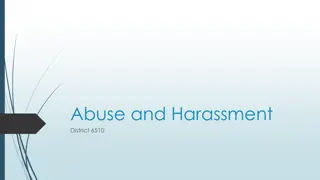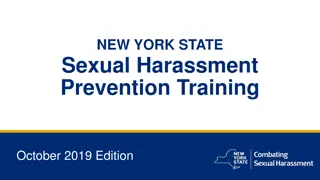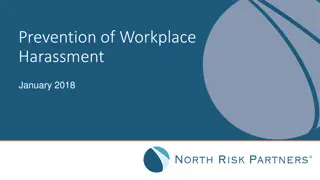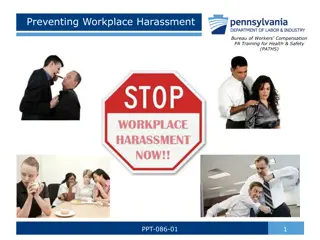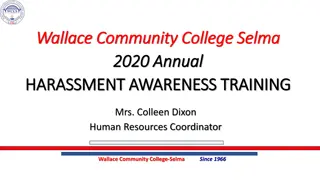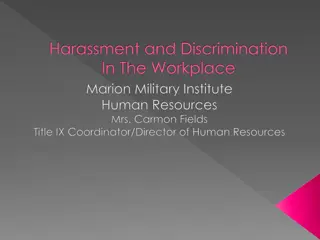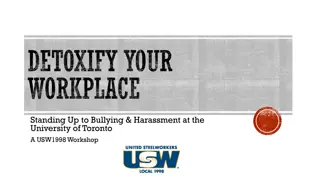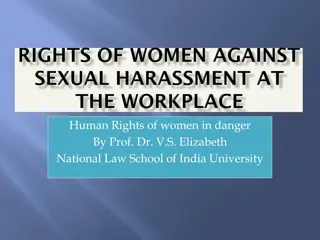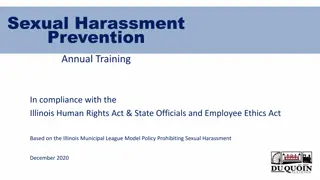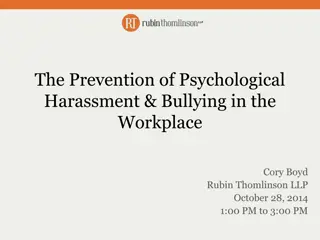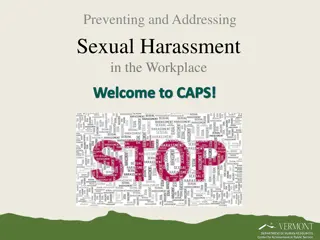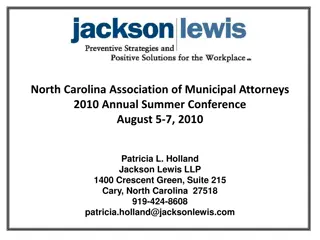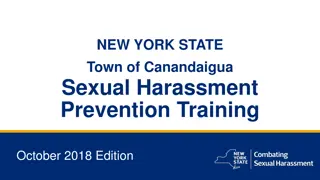Understanding Anti-Harassment Guidelines in Workplace and Other Environments
This content highlights the aim, basic principles, definition, elements, impact, and types of harassment in various environments. It emphasizes the importance of recognizing and preventing harassment, including abuse of authority, sexual harassment, and psychological harassment, to maintain a respectful and safe atmosphere for all individuals.
Download Presentation

Please find below an Image/Link to download the presentation.
The content on the website is provided AS IS for your information and personal use only. It may not be sold, licensed, or shared on other websites without obtaining consent from the author. Download presentation by click this link. If you encounter any issues during the download, it is possible that the publisher has removed the file from their server.
E N D
Presentation Transcript
ANTI- HARASSMENT GUIDELINES
Aim: What constitutes harassment? Harassment in workplace and in other environment (eg- time of disaster).
Basic Principles Courtesy, different customs & cultures. fairly, with dignity & respect for Preservation of human dignity. Every staff, member & volunteer is responsible for ensuring that their own behaviour is not to be seen as harassment. Managers bear the responsibility to ensure & maintain an environment which is free from any forms of harassment & all managers are to take the necessary action in ensuring that the action is taken against all such harassment. necessary appropriate
Definition: Harassment unwelcome reasonably be expected to be perceived to cause offence or humiliation to another. includes conduct any improper has or & that might Harassment may be in the form of words, gestures or actions which tend to annoy, alarm, abuse, demean, intimidate, belittle or cause personal embarassment to another . . humiliation or
2 elements: Unwelcome conduct recipient s feeling & individual perception question. to the act in The behaviour in question must reasonably be expected or be perceived to have the effect of creating an environment. ie: being perceived as unreasonable by a person who knows the facts complained. offensive working
Impact: Conduct is assessed by the impact that such behaviour had on the victim eg- well being, ability to do the job, regular sick-leave. Each individual harassment complaint shall be assessed according severity & impact that recipient. to the has seniority, on it the Types of harassment: Abuse of authority harassment Sexual harassment Psychological harassment
Abuse of authority harassment quid pro quo / sexual blackmail Eg- sexual conduct is requested from a staff member either under the promise of a reward or threat of detrimental action for refusal. Can only be committed by someone with the power to give or take away an employment benefits.
Sexual harassment any unwelcome sexual advance, request for sexual favour, verbal or physical conduct or gesture of a sexual behaviour of a sexual pornography, sexually coloured remarks etc) that has or might reasonably be expected or perceived to cause offence or humiliation to another. nature, or any (including other nature - Both male or female may be the injured party or the offender.
Examples of sexual harassment: Deliberate & unsolicited physical contact. Unnecessary close physical contact. Repeated sexual comments / gestures about a person s appearance or life-style. Offensive phone calls, messages. Questions about a person s private life. Sexually explicit jokes or proposition. Constant invitations to social activities after a person has made it clear that they are not welcome. Unwanted compliments with sexual content. emails, whatsapp
Examples of sexual harassment: name calling darling Use of obscene language. Repeated sexually about a person s body. Nods, winks, fingers, legs or arms & other behaviour which is sexually suggestive. Persistent staring at a person OR part of his/ her body. Display of pornographic web-sites, materials etc. orientated gestures gestures with the hands, *Sexual relationship with subordinates does not only constitute sexual harassment but also UNPROFESSIONAL MANAGEMENT.
Psychological Harassment Eg- Bully or mobbing (gang up against someone) Workplace bullying is repeated offensive, cruel, intimidating, insulting or combined with misuse of power or position to undermine an individual or group of individuals. humiliating behaviour, It can be physical, verbal, visual or written, direct or indirect. Occurs repeatedly, regularly (eg weekly) & over a period of time (eg one month). Single harassment (not bullying). act may be treated as psychological
Example of bullying: Anyone who challenges the bully shall given an overload of works & deadlines reduced. This is done in the hope that he will make mistakes. Criticising comparison. someone through humiliating Making it difficult for someone to perform their job or to take their annual leave.
Example of bullying: Punishing others for being too competent by constant criticism responsibilities by giving them trivial tasks to do. OR removing their Shouting at staffs to get things done. Persistent picking on people in front of others or in private. Keeping individuals in their workplace by blocking their promotion.
Mobbing (gang-up against someone): Usually involves a group of individuals who gang-up on an employee & subject that individual to psychological harassment. Occurs repeatedly & regularly over a period of time. Single act does not constitute mobbing but may be a type harassment . of psychological Examples of mobbing: Making continuous negative remarks about a person OR constantly person. Isolating a person Spreading false rumours or gossiping about someone. criticising the
Examples of non-harassing behaviour: Each case & situation has to be considered individually. Criticising a subordinate s performance & behaviour, even by strong language performance of the subordinate in question is proven. using especially inappropriately if the Changes in job description. Poor working conditions, if based on reasonable managerial decisions. temporary &
Responsibilities: Responsibilities of managers: Special responsibility Take early & swift action on potential & actual harassment. Must not tolerate such continuation. Talk to the parties fairness & impartiality intimidation or favouritism. while demonstrating & free from Anti-harassment session to be part of the basic training course staffs & members. for all volunteers,
Responsibilities volunteers: of all staffs, members & To harassment guidelines. familiarise themselves with the anti- Ensure prevent any form of harassment. & maintain an environment that Duty to report to their manager/superior any harassment acts that LEGITIMATE reason to believe are being carried out by a colleague. they have a Contact the relevant person or authority should they have any application of these guidelines. queries on the





